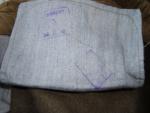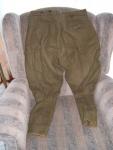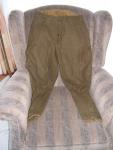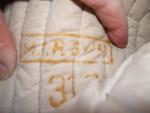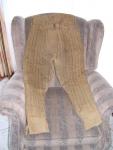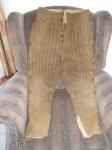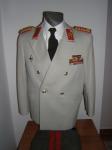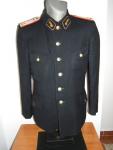-
Posts
4,807 -
Joined
-
Last visited
-
Days Won
12
Content Type
Profiles
Forums
Blogs
Gallery
Events
Store
Everything posted by Gordon Craig
-

Hungary Early Post War Hungarian Trousers
Gordon Craig replied to Gordon Craig's topic in Central & Eastern European States
The only marking in the breeches are on the underside of the rear pocket. One stamp is an inspectors stamp and all that can be made out is the number 9 in the centre and the letters M E O at the bottom of the stamp. The other stamp is the standar marking for this period with two leters in the upper section a lower section divided into two with a legible date of 1952 in the right hand side of the rectangular marking. -

Hungary Early Post War Hungarian Trousers
Gordon Craig replied to Gordon Craig's topic in Central & Eastern European States
-

Hungary Early Post War Hungarian Trousers
Gordon Craig replied to Gordon Craig's topic in Central & Eastern European States
The next set of pants are the wool type breeches worn with the everyday service uniform. The interesting thing about hese pants is that they are virtually identical to those worn during WWII. The buttons are made of the same bakelite material. They have two slash front pockets, a watch pocket and one rear pocket on the right side. The watch pocket and the rear pocket are closed by a button and a tab. Regards, Gordon -

Hungary Early Post War Hungarian Trousers
Gordon Craig replied to Gordon Craig's topic in Central & Eastern European States
Here is the markings in these trousers. A little blurry but hard to hold a digital camera still with one hand. The pants are dated 1953. -

Hungary Early Post War Hungarian Trousers
Gordon Craig replied to Gordon Craig's topic in Central & Eastern European States
-
Gents, One of the hardest parts of a uniform for a collector to acquire are the pants to go with the tunic. Particularly ones with similar wear colour etc. While Charles concentrated on tunics this past show I concentrated on trousers. The first pair up are the heavy winter padded trousers. These pants are very thick and bound to keep you warm but would certainly restrict your movements once you added the jacket. They have two front slash pockets and a watch pocket on the right side. There are no rear pockets. The pants are tapered to fit inside the boots and there is a slit at the bottom to help get the pants on. This slit is not buttoned but is tied closed by two straps, which wrap around the leg, that are sewn into the outside leg seam. If anyone has a tunic to go with these panst please pm me. Regards, Gordon
-

Hungary True 1956 Revolution Tunic
Gordon Craig replied to hunyadi's topic in Central & Eastern European States
Charles, Nice tunic. I should have paid more attention to it on Saturday! Cheers, Gordon -

DDR My first DDR buys
Gordon Craig replied to Grant Broadhurst's topic in Germany: Post 1945: Bundesrepublik & DDR
Grant, The Pestalozzi-Medaille fur true Dienste was introduced on 15.11.1956. They came in Gold for 40 years service (30 years after 1971) Silver for 30 years service (20 years after 1966) and Bronze for 10 years service. Apparently they were 32mm in diametre except from 1966-1973 when they measured 32.4mm. Sources vary on the type of material used to make the medals but they were probably made from nickle until some time in 1986 when they started to make them from iron until the end of the DDR in 1990. Ref: Bartells "DDR-Spezialkatalog 1049-1990" and "Deutsche Ordern und Ehrenzeichen" Regards, Gordon -

Hungary Faked Partisan Badges
Gordon Craig replied to Gordon Craig's topic in Central & Eastern European States
Charles, I sent an email to the Military Museum asking about the numbering of the late issue badges and the answer was "I'll need to do some research but too busy right now. Will get back to you later." In the meantime, any information that can be collected from th Partisan Association will be very welcome. Puting it all together will take some time. Regards, Gordon -

Hungary Hungarian People's Republic Awards
Gordon Craig replied to Ed_Haynes's topic in Central & Eastern European States
Charles, Thanks for adding your specs for your medal. Considerable weigth difference. Be nice to be able to weigh them on the same set of scales. Also, the hieght difference is noticeable but I think I only noticed that the day you bought the medal because we had only left the museum a few minutes prior to the sale. Because I noticed a hieght difference I thnk that Richard was probably correct in his measurement. Be nice to put them side-by-side. Perhaps the enxt time we visit the numismatics section of the military museum. Regards, Godon -

Hungary Faked Partisan Badges
Gordon Craig replied to Gordon Craig's topic in Central & Eastern European States
Gents, Well I finally had time to go back to look at the Partisan badge that I thought was a fake. I think now that it could be as Hunyadi has suggested and that it is actually the last type issued. It is in mint condition and appears to be unnumbered. SO this raises a question. Were the 1966 issue badges numbered? And if not, why not? Were the badges numbered all at once and then awarded as the need arose. This seems to be a logical conclusion considering the award documents Charles and I have studied at the National Museum. Were some of the last Partisan badges produced not awarded and or not numbered and then some how found their way into the collectors field? Questions, questions, questions. The more your study something the more questions you come up with! Cheers, Gordon -

Yugoslavia Yugoslavian Awards
Gordon Craig replied to Ed_Haynes's topic in Southern European & Balkan States
Filip, Thanks for the response. I suspected the vendor was asking too much for the award. His prices are normally high. Now I know for sure. Regards, Gordon -

Hungary Hungarian People's Republic Awards
Gordon Craig replied to Ed_Haynes's topic in Central & Eastern European States
Richard, Thanks for posting these other awards. Interesting that your awards came in a box the vendor said was aspecimin box for the army. What Charles and I saw at the museum was a red box of medals with the war medals plus some others that were regular issue types. It would be great if you would post a picture of interior of the box with all of the medals in place. I would very much like to add a box of medals like we saw at the museum to my collection. It would be the centrepiece of my Hungarian collection. Regards, Gordon -

Yugoslavia Yugoslavian Awards
Gordon Craig replied to Ed_Haynes's topic in Southern European & Balkan States
Gents, I have seen lots of pictures of the Order of Merit 3rd class but no mention of current values. I saw one for sale today and I wonder what I should pay for it? It has silver hall marks on the back. Is that unusual for a third class? Regards, Gordon -
Gents, The Vitezi was reinstitued by an act passed in Hungary in 1993. This act specifically listed previous awards which were no longer to be worn and the reinstitution of some Hungarian awards forbidden by previous regimes. This act also abolished privileges which had previously been attached to the reinstitued awards. Therefore, no land would have been awarded with the Vitezi awarded subsequently. I asume this also applies to the hereditary nature of the award but I am not certain of this. Regards, Gordon
-

Hungary Hungarian People's Republic Awards
Gordon Craig replied to Ed_Haynes's topic in Central & Eastern European States
Richard, Charles, Interesting comparison of the medals. I noticed on the one that Charles has, compared to the ones in the museum, that the measurements appeared to be different but not having the two to compare at the time I couldn't be sure. IE that if you were to lay the medal on a flat surface with the head up and measure from the flat surface to the head side of the medal there is a noticable difference in height. Perhaps it would be useful for us all if both Charles and Richard would post the dimensions and weights of their individual silver medals. Also, that the medals at the museum, like the ones Ricahrd posted, are very smooth on their reverse side while the one Charles bought is not. Regards, Gordon -

DDR Reichsbahn Uniforms
Gordon Craig replied to Gordon Craig's topic in Germany: Post 1945: Bundesrepublik & DDR
Rick, This is the best Internet site that I know of for Reichsbahn info. http://www.eisenbahnraritaeten.de/ The books I have were written by Hartmut Sch?ttge. I have three of his books. They are all titled Eisenbahneruniformen der Deutsche Reichsbahn. The first book covers 1946-1956; the second 1957-1967 and the third 1968-1978. Ive heard that he has writtena fourth book but his web site seems to have disappeared. There are other books in German on the Reichsbahn but I don't have the info on them here with me. Regards, Gordon -

DDR Post your favorite East German DDR uniform
Gordon Craig replied to Paul R's topic in Germany: Post 1945: Bundesrepublik & DDR
Gents, I don't have that many DDR uniforms with me here in Budapest but this one qualifies as my favouite one here. Regards, Gordon -

DDR Reichsbahn Uniforms
Gordon Craig replied to Gordon Craig's topic in Germany: Post 1945: Bundesrepublik & DDR
Rick, There are several very good books on the subject of Reichsbahn uniforms, ranks etc. A big and very popular collecting field in Germany. I'll put a list together, along with some web site addresses, and post them as soon as I can. In the meantime, here is a better shot of the boards. Regards, Gordon -

Hungary Hungarian People's Republic Awards
Gordon Craig replied to Ed_Haynes's topic in Central & Eastern European States
-

Hungary Hungarian People's Republic Awards
Gordon Craig replied to Ed_Haynes's topic in Central & Eastern European States
-

Hungary Hungarian People's Republic Awards
Gordon Craig replied to Ed_Haynes's topic in Central & Eastern European States
Gents, I'd like to add to Hunyadi's pictures of the nice medal he purchased today. The only problem with the purchase was I was standing right next to him and didn't recognize what I was looking at!! At least one of us owns one of theses medals! The series of these medals that Charles has refered to is actually pictured in a book authored by Kenyeres D?nes titled ?Katonai Kit?ntet?sek a Magyar T?rt?nelemben?. Here are photos from the book; -

DDR My DDR tunic
Gordon Craig replied to Alex AU's topic in Germany: Post 1945: Bundesrepublik & DDR
Alex, You have an enlisted man's uniform with an officers set of shoulderboards. The U1 indicates the tunic was made in the first quarter of 1978 and looks as though it was never issued. The k, for klein, indicates a small sized tunic and the 48 indicates a size of US. 38 and European 96. It is a nice tunic for a start. Because of the unused state I would suggest that you get low ranking enlisted man's boards to complete it. Regards, Gordon -

DDR Reichsbahn Uniforms
Gordon Craig replied to Gordon Craig's topic in Germany: Post 1945: Bundesrepublik & DDR
-

DDR Reichsbahn Uniforms
Gordon Craig replied to Gordon Craig's topic in Germany: Post 1945: Bundesrepublik & DDR
Grant, The hats were very similar to those used in the Third Reich period. Especially since EREL was one of the prime maker of hats in that time period. Until the early 50's the Reichsbahn continued to wear their old Third Recih uniforms, with the insignia removed of course. They then produced a new set of uniform regulations and the uniforms changed to a more Russian form, specifically the shoulderboards, as you will see when I post the uniform that came with this hat. Hopefully later today. Regards, Godon


